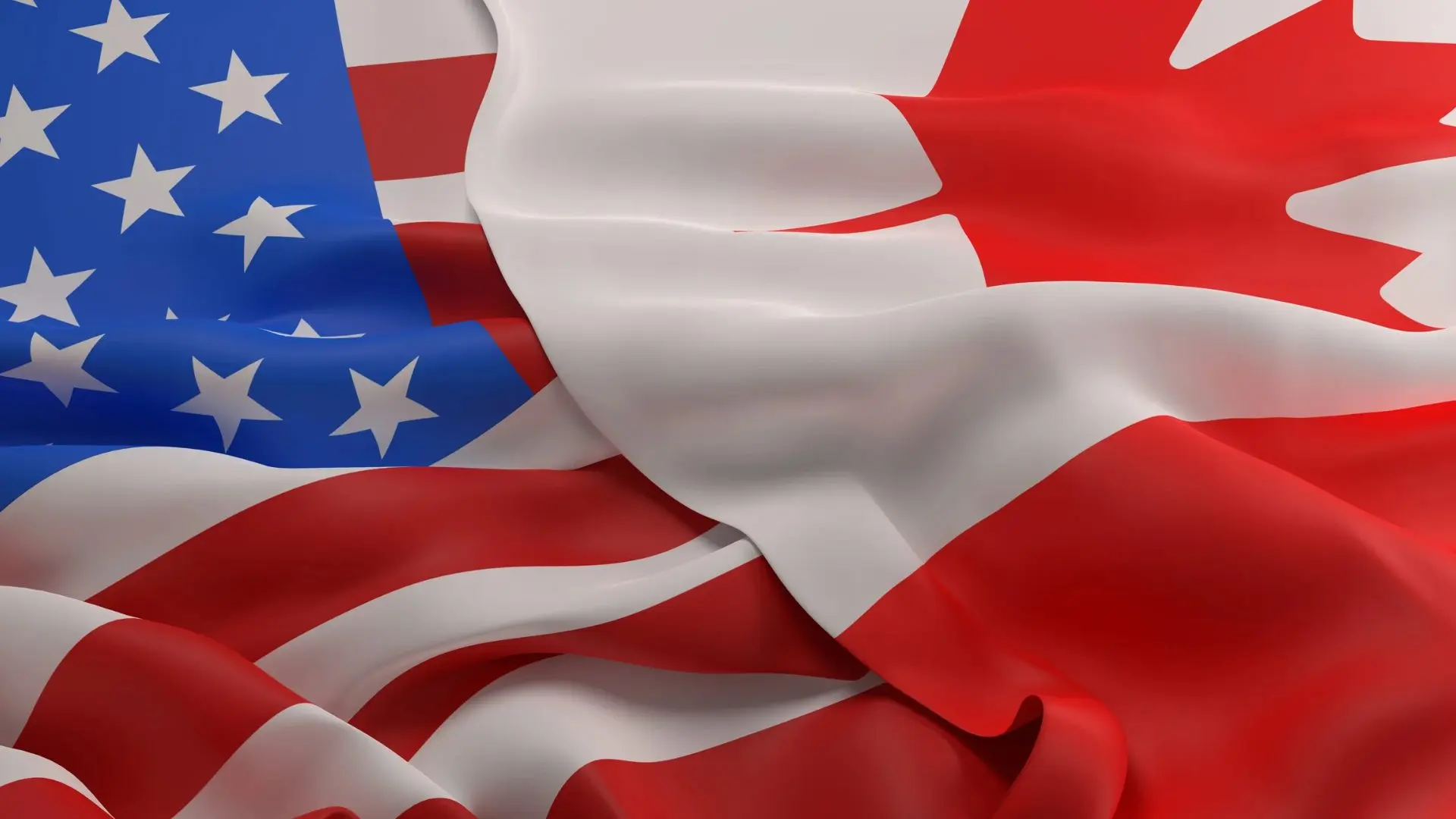Ottawa, ON, Canada (WNEWS) – The long-standing trade relationship between Canada and the United States teeters on the edge of a major disruption. President-elect Donald Trump’s recent proposal to impose a 25% tariff on all Canadian imports has sent shockwaves through both the economic and political landscapes of the two countries. This move, intended to address concerns about illegal immigration and drug trafficking, poses a significant threat to Canada’s economy, potentially leading to a recession and a substantial increase in inflation. Let’s delve deeper into the looming trade war, explore its potential consequences, and examine possible avenues for resolution.
A History of Economic Interdependence
Canada and the United States share one of the most extensive and integrated trade relationships in the world, bolstered by treaties such as NAFTA (now USMCA). With over 75% of Canada’s exports destined for the U.S., this dependency reflects the tight economic bonds between the two nations. Canada is the largest foreign supplier of energy to the U.S., and cross-border trade in goods and services exceeds CAD $2 billion daily.
This deep integration, while beneficial during times of economic cooperation, leaves Canada highly vulnerable to U.S. policy shifts. The proposed tariffs have triggered memories of past trade disputes, such as the 2018 U.S. tariffs on steel and aluminum, which Canada countered with retaliatory measures. But this new scenario, involving a blanket 25% tariff on all Canadian goods, is unprecedented in scale and impact.
The Ripple Effects on Canada’s Economy
1. GDP Contraction and Risk of Recession
Economic modeling from Oxford Economics and the Canadian Chamber of Commerce suggests that Canada’s GDP could shrink by as much as 2.5% by early 2026 if the tariffs are implemented. To put this into perspective, this contraction equates to a loss of CAD $78 billion from the economy, roughly $1,900 per Canadian citizen annually. This level of economic downturn is enough to trigger a technical recession, defined as two consecutive quarters of negative GDP growth.
The most affected sectors would be those heavily reliant on U.S. markets, including energy, automotive manufacturing, and agriculture. For instance, Canada’s oil and gas sector, which accounts for nearly 20% of the nation’s exports, could see a dramatic reduction in revenue as U.S. demand declines. The automotive industry, deeply intertwined with U.S. supply chains, would also face severe disruptions.
2. Unemployment and Regional Impacts
The repercussions of reduced exports would reverberate through the labor market, with projections indicating a substantial 150,000 to 200,000 job losses nationwide. Some economists even anticipate job losses in the hundreds of thousands, with the Ontario unemployment rate potentially doubling. This would lead to a 1.5 percentage point increase in the unemployment rate, potentially reaching levels of around 7.9% by the end of 2025 or even double digits in certain regions. In contrast, the current federal unemployment rate stands at approximately 6.7%, following the addition of 91,000 jobs to the Canadian economy in December.
Ontario Premier Doug Ford warned on Tuesday that a 500,000 job loss could occur if the tariff were imposed on Canada’s goods. It’s worth noting that Ontario currently has approximately 600,000 unemployed individuals.
This is serious, it’s unprecedented, and let’s hope it doesn’t cost 500,000 jobs,” – Premier Doug Ford
The Government of British Columbia issued a warning on Thursday, January 16, that the imposition of Trump tariffs could have significant repercussions for the BC economy. Between 2025 and 2028, these tariffs are projected to cost the province a substantial amount of money, amounting to between $69 Billion CAD. Moreover, the unemployment rate is expected to rise sharply, potentially surpassing 7 percent by 2026. This could lead to the loss of approximately 124,000 jobs. Additionally, the Province warns that government revenues could decrease by between $1.6 Billion and $2.5 Billion CAD as a result of these tariffs.
The major job losses in British Columbia would primarily affect export-oriented industries, the natural resources sector, and manufacturing. These sectors include forestry, wood and paper manufacturing, metal manufacturing, mining, oil and gas, transportation, and retail.
Regions heavily dependent on trade, such as Alberta, Ontario, and Quebec, would bear the brunt of these losses. Alberta’s energy sector, already struggling due to global shifts toward renewable energy, would face further strain. Meanwhile, Ontario’s automotive and manufacturing hubs, reliant on cross-border supply chains, could see layoffs and plant closures.
3. Inflation Surge
Canada’s inflation rate, which has been stabilizing around 3% following the economic recovery from COVID-19, is expected to surge significantly under the tariff scenario. With the Canadian dollar weakening and import prices rising, inflation could climb to 7.2% by mid-2025, according to forecasts.
Imported goods, particularly from the U.S., would become significantly more expensive, impacting everyday items such as food, clothing, and electronics. This inflationary pressure would erode consumer purchasing power, further dampening economic growth.
4. Canadian Dollar Weakness
The Canadian dollar, already hovering at a low of $0.70 USD, could depreciate further, potentially reaching $0.65 USD. While a weaker currency might make Canadian exports more competitive in other global markets, the benefits would be outweighed by the rising costs of imports. This dynamic would place additional strain on Canadian households and businesses.
U.S. Impacts: A Smaller but Noticeable Hit
While the U.S. economy is larger and more diversified, it is not immune to the consequences of a trade war. The proposed tariffs would disrupt supply chains, increase costs for businesses, and push inflation higher, albeit to a lesser degree than in Canada.
1. Disruptions in Key Sectors
- Automotive Industry: The integrated North American auto sector would face significant challenges. U.S. manufacturers, dependent on Canadian parts and materials, could experience production delays and increased costs, reducing competitiveness in global markets.
- Agriculture: Canada is a top buyer of U.S. agricultural products, including corn, soybeans, and dairy. Retaliatory tariffs from Canada could hurt American farmers, particularly in the Midwest.
- Construction: Tariffs on Canadian lumber and aluminum would raise costs for U.S. construction companies, driving up housing prices.
2. Modest Inflation and Job Losses
Inflation in the U.S. could rise by 0.5% to 1.0%, driven by higher costs for goods such as lumber and consumer products. Job losses, while less severe than in Canada, could still affect around 0.5% of the workforce, particularly in sectors with strong Canadian trade ties.
Political and Diplomatic Responses
Canada’s Approach
Prime Minister Justin Trudeau has been vocal in condemning the proposed tariffs, emphasizing their potential harm to both economies. However, Trudeau faces significant domestic challenges. The resignation of Deputy Prime Minister Chrystia Freeland in mid-December, reportedly over disagreements on handling the tariff threat, has weakened his cabinet. In response, Trudeau has ramped up engagement with U.S. business leaders to highlight the interconnectedness of the two economies.
With Trudeau’s recent announcement of resignation, which has sparked a leadership race and prompted Parliament’s prorogation until March 24, the situation has taken a dramatic turn. Consequently, various provinces have responded differently. Alberta Premier Daniele Smith attended a meeting last weekend in Florida with Trump to discuss the tariffs. Ford has called for a cutoff of energy to the states, while some Premiers have suggested imposing an embargo or limiting oil and gas exports to the states. Smith has warned that there’s no way to avoid the tariffs.
I haven’t seen any indication in any of the president’s public commentary, or even in the comments that he had with me, that he’s inclined to change his approach,” – Smith said Monday during an online media conference
Canada is also exploring diversification strategies, seeking to reduce its dependence on the U.S. market by strengthening trade relationships with Europe and Asia. Initiatives such as the Comprehensive and Progressive Agreement for Trans-Pacific Partnership (CPTPP) and the Canada-European Union Comprehensive Economic and Trade Agreement (CETA) are being prioritized.
U.S. Dynamics
In the U.S., business groups and industry associations have expressed concern over the potential tariffs, warning of disruptions to supply chains and higher costs for consumers. While President-elect Trump maintains strong support among his base, including in states that could be affected by Canadian retaliation, opposition from key industries could temper his administration’s willingness to escalate the trade war.
Long-Term Implications and Potential Resolutions
A Looming Shift in Trade Dynamics
If the tariffs are implemented, the long-term impact could reshape North American trade dynamics. Canada may accelerate efforts to diversify its export markets, reducing reliance on the U.S. However, such a shift would take years to materialize, leaving the Canadian economy vulnerable in the interim.
The Role of Diplomacy
Diplomatic efforts will be crucial in de-escalating tensions. The USMCA provides mechanisms for dispute resolution, which Canada could leverage to challenge the tariffs. Additionally, collaboration between industry stakeholders on both sides of the border could help advocate for a more balanced approach.
The Path Forward
Ultimately, the outcome of this trade dispute will depend on the willingness of both nations to prioritize mutual economic stability over short-term political gains. Collaborative solutions, such as targeted exemptions or phased implementation of tariffs, could mitigate the worst impacts.
Conclusion
The proposed 25% U.S. tariffs on Canadian goods present a multifaceted threat to Canada’s economic stability. With potential GDP contraction, surging inflation, rising unemployment, and sector-specific challenges, the Canadian government must navigate these turbulent waters with strategic diplomacy and robust economic policies. The interdependent nature of U.S.-Canada trade relations suggests that collaborative solutions are essential to mitigate the adverse effects on both economies.
Editorial Note: January 16, 2025 – 11:18 AM PST: We’ve added more details to the article about the potential impact on British Columbia, based on information provided by the Government of BC.











